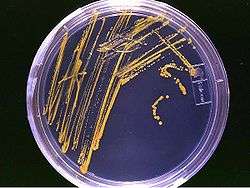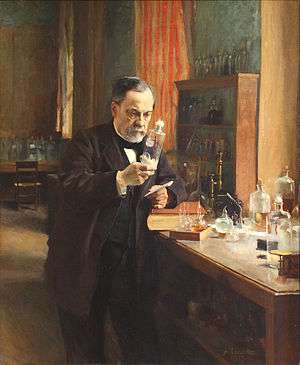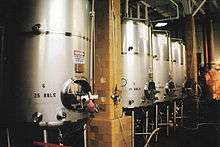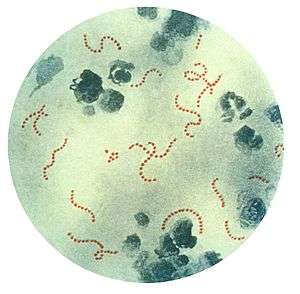Microbiology

Microbiology (from Greek μῑκρος, mīkros, "small"; βίος, bios, "life"; and -λογία, -logia) is the study of microscopic organisms, those being unicellular (single cell), multicellular (cell colony), or acellular (lacking cells).[1] Microbiology encompasses numerous sub-disciplines including virology, mycology, parasitology, and bacteriology.
Eukaryotic micro-organisms possess membrane-bound cell organelles and include fungi and protists, whereas prokaryotic organisms—all of which are microorganisms—are conventionally classified as lacking membrane-bound organelles and include eubacteria and archaebacteria. Microbiologists traditionally relied on culture, staining, and microscopy. However, less than 1% of the microorganisms present in common environments can be cultured in isolation using current means.[2] Microbiologists often rely on extraction or detection of nucleic acid, either DNA or RNA sequences.
Viruses have been variably classified as organisms,[3] as they have been considered either as very simple microorganisms or very complex molecules. Prions, never considered microorganisms, have been investigated by virologists, however, as the clinical effects traced to them were originally presumed due to chronic viral infections, and virologists took search—discovering "infectious proteins".
As an application of microbiology, medical microbiology is often introduced with medical principles of immunology as microbiology and immunology. Otherwise, microbiology, virology, and immunology as basic sciences have greatly exceeded the medical variants, applied sciences.[4][5][6]
Branches
The branches of microbiology can be classified into pure and applied sciences.[7] Microbiology can be also classified based on taxonomy, in the cases of bacteriology, mycology, protozoology, and phycology. There is considerable overlap between the specific branches of microbiology with each other and with other disciplines, and certain aspects of these branches can extend beyond the traditional scope of microbiology.
Pure microbiology
- Bacteriology: The study of bacteria.
- Mycology: The study of fungi.
- Protozoology: The study of protozoa.
- Phycology/algology: The study of algae.
- Parasitology: The study of parasites.
- Immunology: The study of the immune system.
- Virology: The study of viruses.
- Nematology: The study of nematodes.
- Microbial cytology: The study of microscopic and submicroscopic details of microorganisms.
- Microbial physiology: The study of how the microbial cell functions biochemically. Includes the study of microbial growth, microbial metabolism and microbial cell structure.
- Microbial ecology: The relationship between microorganisms and their environment.
- Microbial genetics: The study of how genes are organized and regulated in microbes in relation to their cellular functions. Closely related to the field of molecular biology.
- Cellular microbiology: A discipline bridging microbiology and cell biology.
- Evolutionary microbiology: The study of the evolution of microbes. This field can be subdivided into:
- Microbial taxonomy: The naming and classification of microorganisms.
- Microbial systematic: The study of the diversity and genetic relationship of microorganisms.
- Generation microbiology: The study of those microorganisms that have the same characters as their parents.
- Systems microbiology: A discipline bridging systems biology and microbiology.
- Molecular microbiology: The study of the molecular principles of the physiological processes in microorganisms.
Other
- Nano microbiology: The study of those organisms on nano level.
- Exo microbiology (or Astro microbiology): The study of microorganisms in outer space (see: List of microorganisms tested in outer space)
- Biological agent: The study of those microorganisms which are being used in weapon industries.
- Predictive microbiology: The quantification of relations between controlling factors in foods and responses of pathogenic and spoilage microorganisms using mathematical modelling
Applied microbiology
- Medical microbiology: The study of the pathogenic microbes and the role of microbes in human illness. Includes the study of microbial pathogenesis and epidemiology and is related to the study of disease pathology and immunology. This area of microbiology also covers the study of human microbiota, cancer, and the tumor microenvironment.
- Pharmaceutical microbiology: The study of microorganisms that are related to the production of antibiotics, enzymes, vitamins,vaccines, and other pharmaceutical products and that cause pharmaceutical contamination and spoil.
- Industrial microbiology: The exploitation of microbes for use in industrial processes. Examples include industrial fermentation and wastewater treatment. Closely linked to the biotechnology industry. This field also includes brewing, an important application of microbiology.
- Microbial biotechnology: The manipulation of microorganisms at the genetic and molecular level to generate useful products.

- Food microbiology: The study of microorganisms causing food spoilage and foodborne illness. Using microorganisms to produce foods, for example by fermentation.
- Agricultural microbiology: The study of agriculturally relevant microorganisms. This field can be further classified into the following:
- Plant microbiology and Plant pathology: The study of the interactions between microorganisms and plants and plant pathogens.
- Soil microbiology: The study of those microorganisms that are found in soil.
- Veterinary microbiology: The study of the role of microbes in veterinary medicine or animal taxonomy.
- Environmental microbiology: The study of the function and diversity of microbes in their natural environments. This involves the characterization of key bacterial habitats such as the rhizosphere and phyllosphere, soil and groundwater ecosystems, open oceans or extreme environments (extremophiles). This field includes other branches of microbiology such as:
- Microbial ecology
- Microbially mediated nutrient cycling
- Geomicrobiology
- Microbial diversity
- Bioremediation
- Water microbiology (or Aquatic microbiology): The study of those microorganisms that are found in water.
- Aeromicrobiology (or Air microbiology): The study of airborne microorganisms.
Benefits
While some fear microbes due to the association of some microbes with various human illnesses, many microbes are also responsible for numerous beneficial processes such as industrial fermentation (e.g. the production of alcohol, vinegar and dairy products), antibiotic production and as vehicles for cloning in more complex organisms such as plants. Scientists have also exploited their knowledge of microbes to produce biotechnologically important enzymes such as Taq polymerase, reporter genes for use in other genetic systems and novel molecular biology techniques such as the yeast two-hybrid system.
Bacteria can be used for the industrial production of amino acids. Corynebacterium glutamicum is one of the most important bacterial species with an annual production of more than two million tons of amino acids, mainly L-glutamate and L-lysine.[8] Since some bacteria have the ability to synthesize antibiotics, they are used for medicinal purposes, such as Streptomyces to make aminoglycoside antibiotics.[9]
A variety of biopolymers, such as polysaccharides, polyesters, and polyamides, are produced by microorganisms. Microorganisms are used for the biotechnological production of biopolymers with tailored properties suitable for high-value medical application such as tissue engineering and drug delivery. Microorganisms are used for the biosynthesis of xanthan, alginate, cellulose, cyanophycin, poly(gamma-glutamic acid), levan, hyaluronic acid, organic acids, oligosaccharides and polysaccharide, and polyhydroxyalkanoates.[10]
Microorganisms are beneficial for microbial biodegradation or bioremediation of domestic, agricultural and industrial wastes and subsurface pollution in soils, sediments and marine environments. The ability of each microorganism to degrade toxic waste depends on the nature of each contaminant. Since sites typically have multiple pollutant types, the most effective approach to microbial biodegradation is to use a mixture of bacterial and fungal species and strains, each specific to the biodegradation of one or more types of contaminants.[11]
Symbiotic microbial communities are known to confer various benefits to their human and animal hosts health including aiding digestion, production of beneficial vitamins and amino acids, and suppression of pathogenic microbes. Some benefit may be conferred by consuming fermented foods, probiotics (bacteria potentially beneficial to the digestive system) and/or prebiotics (substances consumed to promote the growth of probiotic microorganisms).[12][13] The ways the microbiome influences human and animal health, as well as methods to influence the microbiome are active areas of research.[14]
Research has suggested that microorganisms could be useful in the treatment of cancer. Various strains of non-pathogenic clostridia can infiltrate and replicate within solid tumors. Clostridial vectors can be safely administered and their potential to deliver therapeutic proteins has been demonstrated in a variety of preclinical models.[15]
History
Ancient times
The existence of microorganisms was hypothesized for many centuries before their actual discovery. The existence of unseen microbiological life was postulated by Jainism which is based on Mahavira’s teachings as early as 6th century BCE.[16] Paul Dundas notes that Mahavira asserted existence of unseen microbiological creatures living in earth, water, air and fire.[17] Jain scriptures also describe nigodas which are sub-microscopic creatures living in large clusters and having a very short life and are said to pervade each and every part of the universe, even in tissues of plants and flesh of animals.[18] The Roman Marcus Terentius Varro made references to microbes when he warned against locating a homestead in the vicinity of swamps "because there are bred certain minute creatures which cannot be seen by the eyes, which float in the air and enter the body through the mouth and nose and there by cause serious diseases."[19]
Medieval Islamic world
.png)
At the golden age of Islamic civilization, some scientists had knowledge about microorganisms, such as Ibn Sina in his book The Canon of Medicine, Ibn Zuhr (also known as Avenzoar) who discovered scabies mites, and Al-Razi who gave the earliest known description of smallpox in his book The Virtuous Life (al-Hawi).[20]
In 1546, Girolamo Fracastoro proposed that epidemic diseases were caused by transferable seedlike entities that could transmit infection by direct or indirect contact, or vehicle transmission.[21]
However, early claims about the existence of microorganisms were speculative, and not based on microscopic observation. Actual observation and discovery of microbes had to await the invention of the microscope in the 17th century.
Modern times
._Natuurkundige_te_Delft_Rijksmuseum_SK-A-957.jpeg)
In 1676, Anton van Leeuwenhoek, who lived most of his life in Delft, Holland, observed bacteria and other microorganisms using a single-lens microscope of his own design.[1] While Van Leeuwenhoek is often cited as the first to observe microbes, Robert Hooke made the first recorded microscopic observation, of the fruiting bodies of moulds, in 1665.[22] It has, however, been suggested that a Jesuit priest called Athanasius Kircher was the first to observe micro-organisms. [23]
He was among the first to design magic lanterns for projection purposes, so he must have been well acquainted with the properties of lenses.[23] One of his books contains a chapter in Latin, which reads in translation – "Concerning the wonderful structure of things in nature, investigated by Microscope." Here, he wrote "who would believe that vinegar and milk abound with an innumerable multitude of worms." He also noted that putrid material is full of innumerable creeping animalcule. These observations antedate Robert Hooke's Micrographia by nearly 20 years and were published some 29 years before van Leeuwenhoek saw protozoa and 37 years before he described having seen bacteria.[23] Joseph Lister was the first person who said infectious diseases are caused by micro-organism and was first person who used phenol as disinfectant on the open wounds of patients.

The field of bacteriology (later a subdiscipline of microbiology) was founded in the 19th century by Ferdinand Cohn, a botanist whose studies on algae and photosynthetic bacteria led him to describe several bacteria including Bacillus and Beggiatoa. Cohn was also the first to formulate a scheme for the taxonomic classification of bacteria and discover spores.[24] Louis Pasteur and Robert Koch were contemporaries of Cohn’s and are often considered to be the father of microbiology[23] and medical microbiology, respectively.[25] Pasteur is most famous for his series of experiments designed to disprove the then widely held theory of spontaneous generation, thereby solidifying microbiology’s identity as a biological science.[26] Pasteur also designed methods for food preservation (pasteurization) and vaccines against several diseases such as anthrax, fowl cholera and rabies.[1] Koch is best known for his contributions to the germ theory of disease, proving that specific diseases were caused by specific pathogenic micro-organisms. He developed a series of criteria that have become known as the Koch's postulates. Koch was one of the first scientists to focus on the isolation of bacteria in pure culture resulting in his description of several novel bacteria including Mycobacterium tuberculosis, the causative agent of tuberculosis.[1]
While Pasteur and Koch are often considered the founders of microbiology, their work did not accurately reflect the true diversity of the microbial world because of their exclusive focus on micro-organisms having direct medical relevance. It was not until the late 19th century and the work of Martinus Beijerinck and Sergei Winogradsky, the founders of general microbiology (an older term encompassing aspects of microbial physiology, diversity and ecology), that the true breadth of microbiology was revealed.[1] Beijerinck made two major contributions to microbiology: the discovery of viruses and the development of enrichment culture techniques.[27] While his work on the Tobacco Mosaic Virus established the basic principles of virology, it was his development of enrichment culturing that had the most immediate impact on microbiology by allowing for the cultivation of a wide range of microbes with wildly different physiologies. Winogradsky was the first to develop the concept of chemolithotrophy and to thereby reveal the essential role played by micro-organisms in geochemical processes.[28] He was responsible for the first isolation and description of both nitrifying and nitrogen-fixing bacteria.[1] French-Canadian microbiologist Felix d'Herelle co-discovered bacteriophages and was one of the earliest applied microbiologists.[29]
See also
References
- 1 2 3 4 5 6 Madigan M, Martinko J (editors) (2006). Brock Biology of Microorganisms (13th ed.). Pearson Education. p. 1096. ISBN 0-321-73551-X.
- ↑ Nitesh RA, Ludwig W, Schleifer KH (2011). "Phylogenetic identification and in situ detection of individual microbial cells without cultivation". Microbiology Rev. 59 (1): 143–169. PMC 239358
 . PMID 7535888.
. PMID 7535888. - ↑ Rice G (2007-03-27). "Are Viruses Alive?". Retrieved 2007-07-23.
- ↑ Penn, M; Dworkin, M (1976). "Casey Harmonh and two visions of microbiology". Bacteriological reviews. 40 (2): 276–83. PMC 413958
 . PMID 786252.
. PMID 786252. - ↑ Symbiosis : An Introduction to Biological Associations: An Introduction to Biological Associations (2nd ed.). New York: Oxford University Press. 2000. p. 10. ISBN 9780198027881. Retrieved 2016-03-25.
- ↑ Smith, KA (2002). "Medical immunology: A new journal for a new subspecialty". Medical immunology (London, England). 1 (1): 1. doi:10.1186/1476-9433-1-1. PMC 131025
 . PMID 12437786.
. PMID 12437786. - ↑ Pharmaceutical Microbiology Principles and Applications. Nirali Prakashan. pp. 1.1–1.2. ISBN 978-81-85790-61-9. Retrieved 18 June 2011.
- ↑ Burkovski A (editor). (2008). Corynebacteria: Genomics and Molecular Biology. Caister Academic Press. ISBN 1-904455-30-1. Retrieved 2016-03-25.
- ↑ Puglisi, Joseph D. (editor). (1996). an Aminoglycoside Antibiotic (PDF). Science. . Retrieved 2016-04-05.
- ↑ Rehm BHA (editor). (2008). Microbial Production of Biopolymers and Polymer Precursors: Applications and Perspectives. Caister Academic Press. ISBN 978-1-904455-36-3. Retrieved 2016-03-25.
- ↑ Diaz E (editor). (2008). Microbial Biodegradation: Genomics and Molecular Biology (1st ed.). Caister Academic Press. ISBN 1-904455-17-4. Retrieved 2016-03-25.
- ↑ MacFarlane, GT; Cummings, JH (1999). "Probiotics and prebiotics: Can regulating the activities of intestinal bacteria benefit health?". BMJ: British Medical Journal. 318 (7189): 999–1003. doi:10.1136/bmj.318.7189.999. PMC 1115424
 . PMID 10195977.
. PMID 10195977. - ↑ Tannock GW (editor). (2005). Probiotics and Prebiotics: Scientific Aspects. Caister Academic Press. ISBN 978-1-904455-01-1. Retrieved 2016-03-25.
- ↑ Humans Carry More Bacterial Cells than Human Ones - Scientific American
- ↑ Mengesha; et al. (2009). "Clostridia in Anti-tumor Therapy". Clostridia: Molecular Biology in the Post-genomic Era. Caister Academic Press. ISBN 978-1-904455-38-7.
- ↑ Mahavira is dated 599 BC - 527 BC. See. Dundas, Paul; John Hinnels ed. (2002). The Jain. London: Routledge. ISBN 0-415-26606-8. p. 24
- ↑ Dundas, Paul (2002) p. 88
- ↑ Jaini, Padmanabh (1998). The Jaina Path of Purification. New Delhi: Motilal Banarsidass. p. 109. ISBN 81-208-1578-5.
- ↑ Varro on Agriculture 1, xii Loeb.
- ↑ Microbiology in Islam http://www.diwanalarab.com/spip.php?article34512 (not in English)
- ↑ Fracastoro, Girolamo (1546), De Contagione et Contagiosis Morbis transl. Wilmer Cave Wright (1930). New York: G.P. Putnam's
- ↑ Gest H (2005). "The remarkable vision of Robert Hooke (1635-1703): first observer of the microbial world". Perspect. Biol. Med. 48 (2): 266–72. doi:10.1353/pbm.2005.0053. PMID 15834198.
- 1 2 3 4 Wainwright, Milton (2003). "An Alternative View of the Early History of Microbiology". Advances in Applied Microbiology. Advances in Applied Microbiology. 52: 333–55. doi:10.1016/S0065-2164(03)01013-X. ISBN 978-0-12-002654-8. PMID 12964250.
- ↑ Drews G (1999). "Ferdinand Cohn, among the Founder of Microbiology". ASM News. 65 (8): 547.
- ↑ Ryan KJ, Ray CG (editors) (2004). Sherris Medical Microbiology (4th ed.). McGraw Hill. ISBN 0-8385-8529-9.
- ↑ Bordenave G (2003). "Louis Pasteur (1822-1895)". Microbes Infect. 5 (6): 553–60. doi:10.1016/S1286-4579(03)00075-3. PMID 12758285.
- ↑ Johnson J (2001) [1998]. "Martinus Willem Beijerinck". APSnet. American Phytopathological Society. Archived from the original on 2010-06-20. Retrieved May 2, 2010. Retrieved from Internet Archive January 12, 2014.
- ↑ Paustian T, Roberts G (2009). "Beijerinck and Winogradsky Initiate the Field of Environmental Microbiology". Through the Microscope: A Look at All Things Small (3rd ed.). Textbook Consortia. § 1–14. Retrieved May 2, 2010.
- ↑ Keen EC (2012). "Felix d'Herelle and Our Microbial Future". Future Microbiology. 7 (12): 1337–1339. doi:10.2217/fmb.12.115. PMID 23231482.
External links
| Wikimedia Commons has media related to Microbiology. |
| Wikisource has original works on the topic: Microbiology |
| At Wikiversity, you can learn more and teach others about Microbiology at the Department of Microbiology |
- nature.com Latest Research, reviews and news on microbiology
- Microbes.info is a microbiology information portal containing a vast collection of resources including articles, news, frequently asked questions, and links pertaining to the field of microbiology.
- Microbiology on In Our Time at the BBC. (listen now)
- Immunology, Bacteriology, Virology, Parasitology, Mycology and Infectious Disease
- Microbiology Video Lectures and Learning Resources
- Annual Review of Microbiology
| Library resources about Microbiology |

